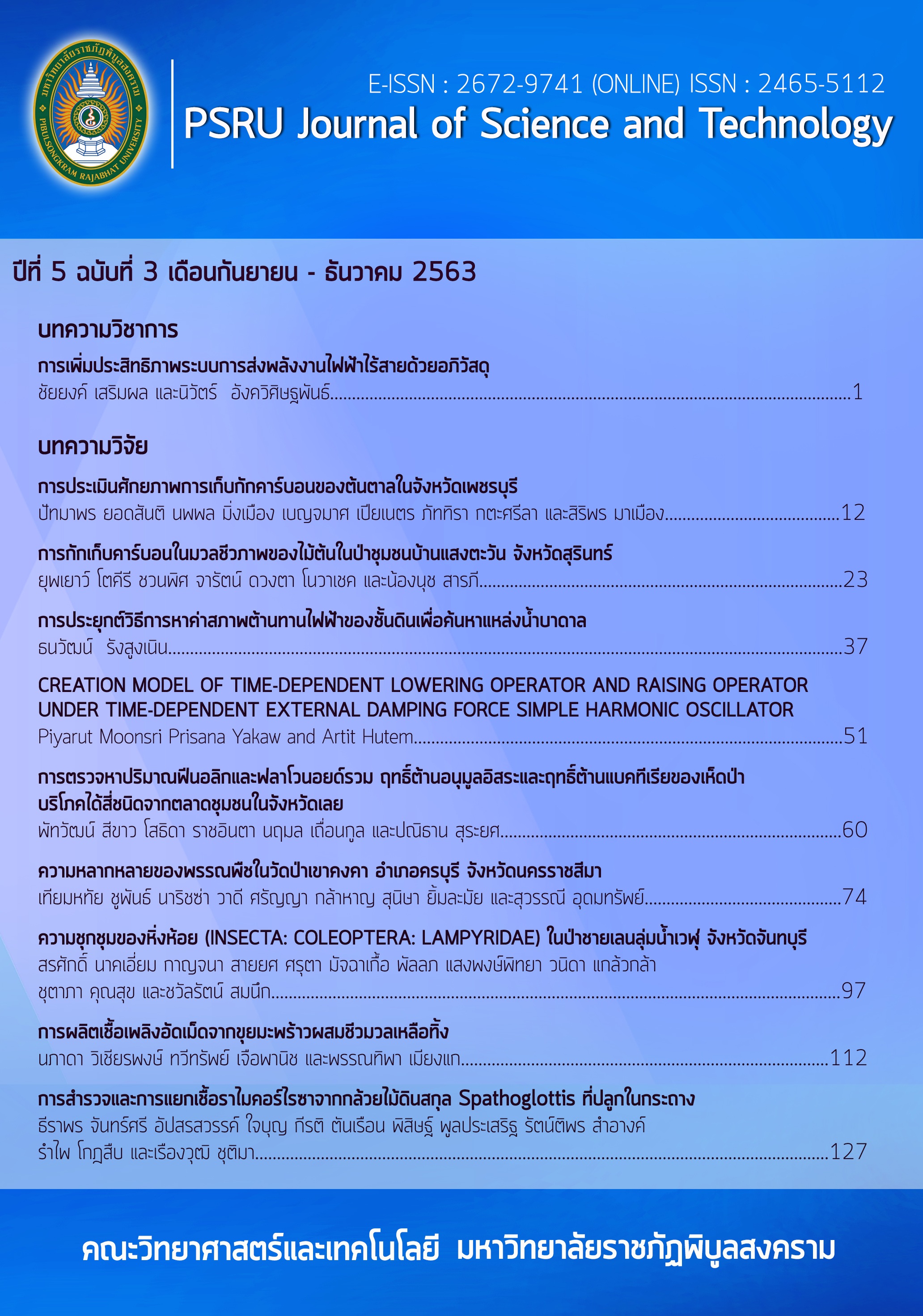DETERMINATION OF TOTAL PHENOLIC AND FLAVONOID CONTENTS, ANTIOXIDANT AND ANTIBACTERIAL ACTIVITIES OF FOUR WILD EDIBLE MUSHROOMS FROM THE COMMUNITY MARKET IN LOEI PROVINCE
Keywords:
Wild edible mushroom, Phenolic, Flavonoid, Antioxidant activity, Antibacterial activityAbstract
The present study determines the total phenolic and flavonoid contents (TPC and TFC), antioxidant and antibacterial activities from the ethanol extract of four wild edible mushrooms bought from the community market in Loei Province: Boletus sp., Boletellus cf. emodensis, Pulveroboletus sp. and Tylopilus sp. The total phenolic and flavonoid contents were evaluated by using Folin-Ciocalteu and aluminum chloride colorimetric methods, respectively. The result indicated that the extract of Boletus sp. extract showed the highest of TPC and TFC, which was 61.69±0.35 mg GAE/g extract and 54.45±0.93 mg RUE/g extract, respectively. The antioxidant activities of the extracts were investigated by 2,2-diphenyl-1-picrylhydrazyl (DPPH), 2,2′-azino-bis (3-ethylbenzthiazoline-6-sulfonic acid) (ABTS) and ferric reducing antioxidant power (FRAP) methods. It was found that Boletus sp. extract exhibited the highest antioxidant activities. The IC50 value by DPPH and ABTS assay were 0.26±0.01 and 1.33±0.07 mg/ml, respectively and the FRAP assay exhibited antioxidant value of 33.14±0.29 FeSO4/g extract. In addition, the antibacterial activity was tested by disc diffusion method. The Boletus sp. extract inhibited Bacillus subtilis, Staphylococcus aureus, Escherichia coli and Proteus vulgaris at concentration of 5 mg/ml. In conclusion, four selected wild bee mushroom will be considered as a source of beneficial bioactive compounds and nutritious food.
References
กาญจนา เสือมั่น, สไมพร ปักษี, อภิญญา อาบสุวรรณ์, รพิกร ฉลองสัพพัญญู, ภรภัทร สำอางค์, ปนัดดา จันทร์เนย, และกุลวดี ปิ่นวัฒนะ. (2562). การวิเคราะห์หาสารต้านอนุมูลอิสระในข้าวไรซ์เบอร์รี่และข้าวหอมดอกมะลิ 105. PSRU Journal of Science and Technology, 4(3), 95-108.
เทพอัฟสร แสนสุข. (2560). ภูมิปัญญาท้องถิ่นและความหลากหลายทางชีวภาพของเห็ดที่พบในเขตพื้นที่วนอุทยานภูเขาไฟกระโดง ตำบลเสม็ด อำเภอเมือง จังหวัดบุรีรัมย์. วารสารวิทยาศาสตร์ มข., 45(2), 434-353.
ธารทิพย์ รัตนะ, และธนากร แสงสง่า. (2559). สมบัติต้านอนุมูลอิสระและพรีไบโอติกของเห็ดป่าสะแกราช.วารสารวิทยาศาสตร์และเทคโนโลยี, 24(4), 538-550.
น้ำฝน เบ้าทองคำ, และถนอมนวล พรหมบุญ. (2557). สารต้านอนุมูลอิสระและปริมาณสารฟีนอลิกทั้งหมดของเห็ดป่าจากชุมชนบ้านน้ำจาง จังหวัดเพชรบูรณ์. Rajabhat Journal of Sciences, Humanities and Social Sciences, 15(2), 96-103.
มลธิรา จันทร์โอภาส, วารุณี จันทร์โอภาส, ธัชคณิน จงจิตวิมล, อัญชลี เชียงกูล, และปรียานันท์ แสนโภชน์. (2549). การสำรวจชนิดของเห็ดราขนาดใหญ่บริเวณเขตรักษาพันธุ์สัตว์ป่าดอยเวียงหล้า จังหวัดแม่ฮ่องสอน. NU Science Journal, 2(2), 175-181.
มลธิรา ศรีถาวร, พุทธวรรณ วาตะ, จิระดา พรมลา, และสาคร ชินวงค์. (2562). ฤทธิ์ต้านแบคทีเรียและฤทธิ์ต้านสารอนุมูลอิสระของสารสกัดหยาบส่วนดอกและส่วนเส้นใยของเห็ดถั่งเช่าสีทอง. วารสาร Veridian E-Journal สาขาวิทยาศาสตร์และเทคโนโลยี, 6(5), 33-47.
สิริลักษณ์ สีหะนันท์, วสันณ์ เพชรรัตน์, และสมปอง เตชะโต. (2550). เห็ดโบลีทส์บางชนิดในประเทศไทย. Songklanakarin Journal Science Technology, 29(3), 737-754.
Azieana, J., Zainon, M.N., Noriham A. & Rohana, M.N. (2017). Total phenolic and flavonoid content and antioxidant activities of ten Malaysian wild mushrooms. Open Access Library Journal, 4, 1-9.
Bernas, E., Jaworska, G. & LisiewaskaZ. (2006). Edible mushroom as a source of valuable nutritive constituents. Acta Scientiarum Polonorum Technologia Alimentaria, 5(1), 5-10.
Bhargava, S., Dhabhai, K., Batra, A., Sharma, A., & Malhotra, B. (2012). Zingiberofficinale: Chemical and phytochemical screening and evaluation of its antimicrobial activities. Journal of Chemical and Pharmaceutical Research, 4, 360-64.
Choi, Y.M., Ku, J.B., Chang, H.B. & Lee, J. (2005) Antioxidant activities and total phenolics of ethanol extracts from several edible mushrooms produced in Korea. Food Science Biotechnology, 14(5), 700-703.
Gan, C.H., Nurul Amira, B. & Asmah, R. (2013). Antioxidant analysis of different types of edible mushrooms (Agaricus bisporous and Agaricus brasiliensis). International Food Research Journal, 20(3), 1095-1102.
Kaur, M., Asthir, B. & Mahajan, G. (2017). Variation in antioxidant, bioactive compounds and antioxidant capacity in germinated and ungerminated grains of ten rice cultivars. Rice Science, 24(6), 349-359.
Kumar, K. (2015). Role of edible mushrooms as functional foods-A review. South Asian Journal of Food Technology and Environment, 1(3&4), 211-218.
Mergan, N., Duru, M.E., Turkoglu, A., Gerzer, K., Kivrak, I. & Turkoglu, H. (2006). Antioxidant and antimicrobial properties of ethanolic extract from Lepista nuda (Bull.) Cooke. Annals of Microbiology, 56(40), 339-344.
Pang, Y., Ahmed, S., Xu, Y., Beta, T., Zhu, Z., Shao, Y. & Bao, J. (2018). Bound phenolic compounds and antioxidant properties of whole grain and bran of white, red, and black rice. Food Chemistry, 240, 212-221.
Phattayakorn, K. Pajanyor, P., Wongtecha, S., Prommakool, A. & Savebowon, W. (2016). Effect of germination on total phenolic content and antioxidant properties of “Hang” rice. International Food Research Journal, 23(1), 406-409.
Rahimah, S.B., Djunaedi, D.D., Soeroto, A.Y. & Bisri, T. (2019). The phytochemical screening, total phenolic contents and antioxidant activities in vitro of white oyster mushroom (Pleurotus Ostreatus) preparations. Open Access Macedonian Journal of Medical Science, 7(15), 2404–2412.
Stojković, D.S., Reis, F.S., Ćirić, A., Barros, L., Glamočlija, J., Ferreira, I.C.F.R. & Soković, M. (2015). Boletus aereus growing wild in Serbia: chemical profile, in vitro biological activities, inactivation and growth control of food-poisoning bacteria in meat. Journal of Food Science and Technology, 52(11), 7385–7392.
Turkoglu, A., Duru, A.M., & Mercan, N. (2007). Antioxidant and antimicrobial activity of Russula delica Fr: an edidle wild mushroom. Eurasian Journal of Analytical Chemistry, 2(1), 54-67.
Valverde, M.E., Hernández-Pérez, H. & Paredes-López, O. (2014). Edible mushrooms: improving human health and promoting quality life. International Journal of Microbiology, 2015, 1-14.
Vararat, S., Managi,t C., Iamthanakul, L., Soparat, W. & Kamkean, N. (2010). Examination of antioxidant activity and development of rice bran oil and gamma-oryzanolmicroemulsion. Journal Health Research, 24(2), 67-72.
Vichit, W. & Saewan, N. (2015). Antioxidant activities and cytotoxicity of Thai pigmented rice. International Journal of Pharmaceutical Science, 7(7), 329-334.
Downloads
Published
How to Cite
Issue
Section
License
กองบรรณาธิการขอสงวนสิทธิ์ในการปรับปรุงแก้ไขตัวอักษรและคำสะกดต่างๆ ที่ไม่ถูกต้อง และต้นฉบับที่ได้รับการตีพิมพ์ในวารสาร PSRU Journal of Science and Technology ถือเป็นกรรมสิทธิ์ของคณะวิทยาศาสตร์และเทคโนโลยี มหาวิทยาลัยราชภัฏพิบูลสงคราม และ
ผลการพิจารณาคัดเลือกบทความตีพิมพ์ในวารสารให้ถือมติของกองบรรณาธิการเป็นที่สิ้นสุด







